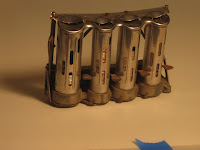
For the final two classes I will be reviewing your semester's work. I would also like you to continue with the development of the Idea Studio project up until the last class next Tuesday.
As a result of the conversations we have had in class over the past few weeks it is apparent that not everybody is keeping separate notebooks for the Conceptual and the "Traditional" sketchbooks. We had determined that most peoples sketchbooks were a hybrid. I ask that you devise some system for navigating the hybrid. This means imposing some (artificial) order on the material for the sole purpose of the in-class presentation. You should also be ready to present the other projects that we worked on in class. Please bring your laptops to class if you have digital elements in your presentation. Check the older posts for an idea of what I expect.
For the final class we will be projecting from a computer linked to the web. The purpose of this will be to explore in class some of the Astitst Notebook sites that I have liknked to this blog as well as others you may have links to as well. I will expect to see you on the final day of class. There will be a real and virtual experience available to you that day.
Here is a list of the assignments:
Criteria for Credit:
Attendance for all classes, lectures, slide presentations and critiques; excused
absences only; assigned work missed, must be made up.
Participation in class
Quality of work
One major project resulting from sketchbook explorations. This may be done in conjunction with another class. All sketches and final project must be presented together in-class, during the fourteenth week of the course.
Four, or more completed sketchbooks showing significant effort. One of these should be a “source-box”. In addition, a brief digital sketchbook should be presented in some form for classroom viewing.
Sketchbooks required for credit:
Traditional sketchbook – containing a visual language concerned with training the eye and the hand; observing and absorbing visual information; drawing from memory; developing studies for a final work – to be used for most of your in-class sketches and should be with you when we visit different locations and generally at all times. (Observational studies)
Conceptual Sketchbook/Notebook – addressing ideas in both visual and written language beyond what is concrete and observed, possibly for exploring radical ideas pushed to the limit or, putting to formal use what were observational studies – to include a lot of writing so that ideas are clarified verbally and visually. (Abstract and conceptual studies)
Final Project – a major work that emerges from the explorations in a sketchbook or, sketchbooks from this course or, might develop through the conceptual sketchbook evolving through writing as well as visual studies – This project may become finalized in conjunction with another course. Both studies and finished work must be presented together to the class before the end of the term. (Final project)
“Source” Box – to collect materials that have some meaning or stimulate some artistic interest. This may include objects, notes, doodles, newspaper articles, postcards, photographs, sketches, measurements, marks, notes, scraps of drawings or paintings, or colors, collage materials, found objects, non-perishable, non-toxic garbage from the street, etc. This may be a collection of eclectic objects and notations for future reference or, it may be a collection specific to one idea. (sketchbox)
Electronic Sketchbook – a brief exploration of the digital approach to a sketchbook to be investigated outside of class. (Digital sketchbook/notebook flickr, facebook, website or blog)etc.
Attendance for all classes, lectures, slide presentations and critiques; excused
absences only; assigned work missed, must be made up.
Participation in class
Quality of work
One major project resulting from sketchbook explorations. This may be done in conjunction with another class. All sketches and final project must be presented together in-class, during the fourteenth week of the course.
Four, or more completed sketchbooks showing significant effort. One of these should be a “source-box”. In addition, a brief digital sketchbook should be presented in some form for classroom viewing.
Sketchbooks required for credit:
Traditional sketchbook – containing a visual language concerned with training the eye and the hand; observing and absorbing visual information; drawing from memory; developing studies for a final work – to be used for most of your in-class sketches and should be with you when we visit different locations and generally at all times. (Observational studies)
Conceptual Sketchbook/Notebook – addressing ideas in both visual and written language beyond what is concrete and observed, possibly for exploring radical ideas pushed to the limit or, putting to formal use what were observational studies – to include a lot of writing so that ideas are clarified verbally and visually. (Abstract and conceptual studies)
Final Project – a major work that emerges from the explorations in a sketchbook or, sketchbooks from this course or, might develop through the conceptual sketchbook evolving through writing as well as visual studies – This project may become finalized in conjunction with another course. Both studies and finished work must be presented together to the class before the end of the term. (Final project)
“Source” Box – to collect materials that have some meaning or stimulate some artistic interest. This may include objects, notes, doodles, newspaper articles, postcards, photographs, sketches, measurements, marks, notes, scraps of drawings or paintings, or colors, collage materials, found objects, non-perishable, non-toxic garbage from the street, etc. This may be a collection of eclectic objects and notations for future reference or, it may be a collection specific to one idea. (sketchbox)
Electronic Sketchbook – a brief exploration of the digital approach to a sketchbook to be investigated outside of class. (Digital sketchbook/notebook flickr, facebook, website or blog)etc.














